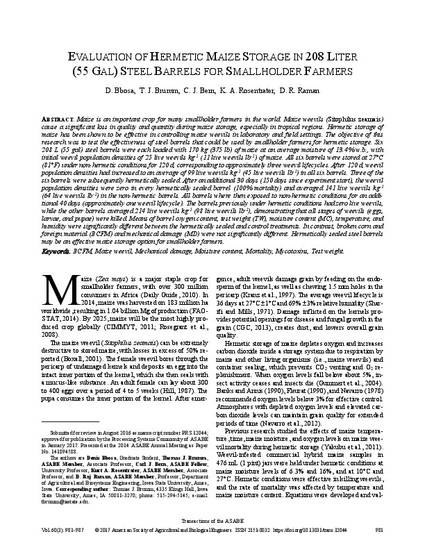
Maize is an important crop for many smallholder farmers in the world. Maize weevils () cause a significant loss in quality and quantity during maize storage, especially in tropical regions. Hermetic storage of maize has been shown to be effective in controlling maize weevils in laboratory and field settings. The objective of this research was to test the effectiveness of steel barrels that could be used by smallholder farmers for hermetic storage. Six 208 L (55 gal) steel barrels were each loaded with 170 kg (375 lb) of maize at an average moisture of 13.4% w.b., with initial weevil population densities of 25 live weevils kg-1 (11 live weevils lb-1) of maize. All six barrels were stored at 27°C (81°F) under non-hermetic conditions for 120 d, corresponding to approximately three weevil lifecycles. After 120 d, weevil population densities had increased to an average of 99 live weevils kg-1 (45 live weevils lb-1) in all six barrels. Three of the six barrels were subsequently hermetically sealed. After an additional 30 days (150 days since experiment start), the weevil population densities were zero in every hermetically sealed barrel (100% mortality) and averaged 141 live weevils kg-1 (64Â live weevils lb-1) in the non-hermetic barrels. All barrels where then exposed to non-hermetic conditions for an additional 40 days (approximately one weevil lifecycle). The barrels previously under hermetic conditions had zero live weevils, while the other barrels averaged 214 live weevils kg-1 (98 live weevils lb-1), demonstrating that all stages of weevils (eggs, larvae, and pupae) were killed. Means of barrel oxygen content, test weight (TW), moisture content (MC), temperature, and humidity were significantly different between the hermetically sealed and control treatments. In contrast, broken corn and foreign material (BCFM) and mechanical damage (MD) were not significantly different. Hermetically sealed steel barrels may be an effective maize storage option for smallholder farmers.
Available at: http://works.bepress.com/cjbern/72/

This article is published as Bbosa, Denis, Thomas J. Brumm, Carl J. Bern, Kurt A. Rosentrater, and D. Raj Raman. "Evaluation of Hermetic Maize Storage in 208 Liter (55 Gal) Steel Barrels for Smallholder Farmers." Transactions of the ASABE 60, no. 3 (2017): 981-987. DOI: 10.13031/trans.12044. Posted with permission.